
Topics
Guests
- Kirstin Downeyauthor of The Woman Behind the New Deal: The Life of Frances Perkins, FDR’s Secretary of Labor and His Moral Conscience. She was a staff writer for the Washington Post for twenty years. In 2008, she shared a Pulitzer Prize for the Post’s coverage of the Virginia Tech shootings.
The current financial crisis is widely described as the nation’s worst since the Great Depression. With the comparisons to the 1930s has come a renewed focus on the New Deal, the government initiative of social programs and public service jobs launched by President Franklin Delano Roosevelt. A new book argues that no voice in the FDR administration was more influential in shaping the New Deal than Labor Secretary Frances Perkins, the first-ever woman cabinet member in the United States. The book is called The Woman Behind the New Deal: The Life of Frances Perkins, FDR’s Secretary of Labor and His Moral Conscience. We speak with author Kirstin Downey. [includes rush transcript]
Transcript
AMY GOODMAN:
The current financial crisis is widely described as the nation’s worst since the Great Depression. With the comparisons to the 1930s has come a renewed focus on the New Deal, the government initiative of social programs and public service jobs launched by President Franklin Delano Roosevelt. Advocates for a just and sustainable economic recovery hope its legacy can be revived. The New Deal came out of immense public pressure and a White House inner circle that helped turn popular demands into policy.
A new book argues no voice in the FDR administration was more influential in shaping the New Deal than the Labor Secretary, Frances Perkins, the first-ever woman cabinet member in the United States. The book is called The Woman Behind the New Deal: The Life of Frances Perkins, FDR’s Secretary of Labor and His Moral Conscience. Author Kirstin Downey joins me now here in Washington, D.C. She was a staff writer for the Washington Post for twenty years and in 2008 shared a Pulitzer Prize for the Post’s coverage of the Virginia Tech shootings.
We welcome you to Democracy Now!
KIRSTIN DOWNEY:
Thank you.
AMY GOODMAN:
Talk about the significance, Kirstin, of Frances Perkins, how — the role she played in laying down the New Deal, the programs she was instrumental in getting passed.
KIRSTIN DOWNEY:
Well, I think the really interesting thing about Frances Perkins is that she was a rather reluctant cabinet secretary. She was very worried about what her life would be like in Washington, if she were to join FDR here. She had been his industrial commissioner for four years in New York. They were already close friends. In exchange for agreeing to take the job, she gave him pretty much a list of demands of what she would insist on happening if she were to become Secretary of Labor. And they are the things that we consider the New Deal now. They’re forty-hour workweek, workers’ compensation as a national program, unemployment compensation, Social Security, a ban on child labor, and national health insurance.
AMY GOODMAN:
I want to turn to a clip of Frances Perkins speaking about the Social Security Act of 1935, known as one of her greatest achievements. In 1960, twenty-five years after its passage, Perkins reflected on how Social Security came about.
FRANCES PERKINS:
We were not yet out of the woods of the Great Depression. And, of course, it was the Great Depression, which we must never forget in this country, which was the proximate cause of this movement, which was launched at that time, this movement, to write under the — under the lives of the American people a basis of security, which came to them out of the orderly and substantial and regular contributions to their future and to the future hazards. It would not have been done in that year, I am sure, except for the fact that the Great Depression was still staring us in the face, and we were conscious of it whenever we walked on the streets of Washington.
AMY GOODMAN:
Frances Perkins talking in 1960 about the act that had been passed twenty-five years before, in 1935, the Social Security Act. Talk about actually how it happened, I think especially for people involved in social movements, Kirstin Downey, to understand the mechanism of change, how Social Security was passed.
KIRSTIN DOWNEY:
I think that one of the things that we sort of need to put in context here is that the Great Depression wasn’t the first economic cataclysm that people who were in their fifties and sixties had experienced. It was the fourth. You know, we had a very bad downturn in 1893, a bad one in 1907. Things had been very bad in the early 1920s after the First World War. People saw that part of capitalism was a recurring boom-and-bust cycle.
What they were seeking to do with Social Security was to create a shock absorber system for capitalism that would give people — that would give people a grace period to survive or, if they got to the end of their lives and their investments hadn’t turned out the way they thought, despite a lifetime of working, that there would be a safety net for you. The unemployment insurance and Social Security, in particular, were — came out of that understanding that we will have boom times, we will have bust times. During the boom times, we will prosper, capitalism will recover. But we need a way to help human beings get through if they hit a bust at a time that they can’t deal with it anymore.
AMY GOODMAN:
Aren’t we seeing the same struggles today? I mean, you had Hoover, you had the Hoovervilles all over the country. He was saying that the economy was going to be OK. Then you have FDR. He, himself, may not have come up with these plans without that inner circle of people like Henry Wallace and Frances Perkins and the New York social worker Harry Hopkins. But those who were saying you needed the government to help. But the others who were saying, you don’t have the government intervene; that’s socialism.
KIRSTIN DOWNEY:
There was that feeling and always a concern. But the Great Depression was such a devastating event. I think a lot of people forget how afraid business became during this period. Observers in Europe said that American capitalists lost, completely lost, self-confidence, that the things they had done had, in many cases, led to economic disaster. And so, there was a great sense that new systems needed to be established. And later, once business began to recover somewhat, there was a resistance later to some of the New Deal programs. And in fact, you know, Roosevelt and his allies dropped some of the early things they had done, essentially dropped like the National Industrial Recovery Act. But early on, there was a great awareness that something dramatic had to happen. It’s notable that in the early months of the Roosevelt administration, when he went to the Chamber of Commerce, he received a standing ovation.
AMY GOODMAN:
Last week marked the ninety-eighth anniversary of the Triangle Shirtwaist Factory fire, which had a huge influence on Frances Perkins. On March 25, 1911, nearly 150 garment workers, mostly women, died after a fire broke out at the Triangle Factory in New York. I wanted to turn to a radio piece I produced in 1986, along with Kathy Dobie, to mark what was then the fire’s seventy-fifth anniversary.
PAULINE PEPE: I worked right near where the fire was. There was cutters there. They were cutting the material. And as soon as they were just going out, it was time to go home. It was 4:00 on Saturday.
AMY GOODMAN:
Pauline Pepe is a ninety-four-year-old survivor of the Triangle fire.
PAULINE PEPE: I saw the fire in the tables, where they were all filled with lingerie material, you know. And that come up in a flame. When I saw that, I ran out. I went to the door that was closed. I didn’t know that was closed. I went there, and I found the door closed. I just stood there ’til they opened it. Forty people going down the steps, we all tumbling one right after another. And I saw people throwing themselves from the window. And as soon as we went down, we couldn’t get out, because the bodies were coming down. It was terrible.
KATHY DOBIE: The women that died that late afternoon were young Jewish and Italian immigrants. When the fire broke out, they tried to escape down the stairs but found the doors had been locked. The owners believed that, given the chance, workers would sneak out with stolen material, and union organizers would sneak in.
AMY GOODMAN:
Some of the women climbed onto the single fire escape. It collapsed. As onlookers watched, women fell nine stories to the sidewalk below. Inside the factory, the fire spread quickly, and with no exit left to them, the women climbed through the windows and leapt to their death. While some union members walked in the vigil, others took buses to a Brooklyn cemetery, where seven unidentified Triangle victims lie buried. Union members pay their respects and read the stone marker above the women’s graves.
UNION MEMBERS: In sympathy and sorrow, citizens of New York raise this monument over the grave of unidentified women and children, who, with 139 others, perished by fire in the Triangle Shirtwaist Factory, Washington Place, March 25th, 1911.
AMY GOODMAN:
I produced that piece with journalist Kathy Dobie. Well, Frances Perkins happened to be just blocks away when the fire broke out. In 1964, she recalled watching the workers jump to their deaths.
FRANCES PERKINS:
Everybody who jumped — and a good many did jump from the ninth and tenth floors —- was killed. And the other people who died were all people who were burned or smothered by the smoke in the factory itself.
This made a terrible impression on the people of the state of New York. I can’t begin to tell you how disturbed the people were everywhere. It was as though we had all done something wrong. It shouldn’t have been. We were sorry. Mea culpa, mea culpa. We didn’t want it that way; we hadn’t intended to have 147 girls and boys killed in a factory. It was a terrible -— it was a terrible thing for the people of the City of New York and the state of New York to face.
I remember that Al Smith — the action happened on a Saturday. I happened to have been visiting a friend in the park on the other side of the park, and we heard the engines, and we heard the screams and rushed out and rushed over where we could see the trouble was. We could this building from Washington Square, and the people had just begun to jump when we got there. They had been holding until that time, standing in the windowsills, crowding, being crowded by others behind them, and the fire pressing closer and closer, the smoke closer and closer.
Finally, the men were trying to put up — trying to get out this thing that the firemen carry with them, a net, to catch people if they do jump. And they were trying to get that out, and they couldn’t wait any longer. I mean, they began to jump. This is when the window was too crowded, and they were jumping. They hit the sidewalk. The net broke. It was a terrible distance, and the weight of the bodies was so great at the speed at which they were traveling that they broke through the net. And every one of them was killed. Everybody who jumped was killed. And it was a horrifying spectacle.
AMY GOODMAN:
The fire helped spur a wave of organizing for unionization and workplace safety regulation. As a New York state official, Frances Perkins was instrumental in reforming the New York labor laws to protect worker safety.
KIRSTIN DOWNEY:
That’s exactly right.
FRANCES PERKINS:
Much of the legislation was enacted into law, oh, within a couple of years, I mean, you know, hearings and so forth and bringing out the supporters and modifying the bill, so that we got — we really got a big draw out of that one episode, which, as I’ve thought of it afterwards, seems in some way to have paid the debt that society owed to those children, those young people, who lost their lives in the Triangle fire. It’s their contribution to the people of New York that we have this really magnificent series of legislative acts to protect and improve the administration of the law regarding the protection of workpeople in the City of — in the state of New York.
AMY GOODMAN:
That was Frances Perkins speaking in 1964. Our guest is Kirstin Downey, who has written the book about Frances Perkins, The Woman Behind the New Deal. Kirstin, the significance of this fire for so much that — labor law that came after this and Frances Perkins’s centrality to it all?
KIRSTIN DOWNEY:
Well, I think that’s one of the things that’s really fascinated me, riveted me to the story of Frances Perkins and her life, is I was very taken by the fact that this young woman — she was only thirty years old when she saw the fire — witnessed a terrible spectacle. Now, thousands of people were dying in workplace fires all over the country at that time, but this particular fire is viewed by a lot of New Yorkers, but it’s also viewed by this very dynamic young woman. She decides — it galvanizes her. She says this has to change.
She’s a descendant of Revolutionary War patriots. She has a great sense of moral responsibility for the country being the kind of place that it should be. And she thinks that what’s happening to these factory workers is just wrong.
Teddy Roosevelt selects her to be executive director of the — executive secretary of the Committee on Safety. And I found that in documents at the Library of Congress. Even a lot of Teddy Roosevelt scholars didn’t know that. And she leads the charge. She does it in her characteristic way of making alliances with unlikely partners. You see her, of course, gathering all the idealists together, all the people that she describes as looking in shock and terror, but she also finds ways to reach out to the insurance companies to convince them that fire hazards are something that they should be considering a financial issue. She gets insurance company executives to talk to real estate owners.
And she is instrumental in creating a legislative committee in the state of New York that holds fact-finding hearings all around the state to discuss hazards of all kinds. Out of that comes much legislation and things that have had effects on all of us today: occupancy limitations, fire exits, even removing trash, flammable trash, every night from workplaces. These all came from Frances Perkins’s work in New York at that time.
AMY GOODMAN:
Kirstin Downey, let’s go on. As we talk about issues like Social Security, the forty-hour work week, which was a demand of socialists early on, in fact, interestingly, Frances Perkins had a socialist background.
KIRSTIN DOWNEY:
That’s exactly right. When she was a young woman, she became a socialist, I guess you’d say. But, Amy, you have to remember that when she became a socialist, women didn’t even have the right to vote. So I suppose it was more a political statement of support rather than anything that you could vote on if you’re a woman at that time. But she — many of the things that were — became part of the New Deal were socialist ideals: an eight-hour day and unemployment insurance. Those were socialist ideals. She later, after she was — became a civil servant and worked with Al Smith in New York, she joined the Democratic Party.
AMY GOODMAN:
Now talk about what she was not able to accomplish, the key issue that she felt needed to be passed, but to get Social Security, to get these other labor issues passed, she gave up on national health insurance, national healthcare.
KIRSTIN DOWNEY:
That’s exactly right. And that was a source of great disappointment to her. She revisits it. She was with FDR for the entire twelve years until his death. And you see her come back to this issue again and again.
They initially thought in the package of pieces that were part of Social Security, which was unemployment insurance, Social Security and aid to dependent children, which at that point was really aid to widows with children, they had thought that national health insurance would sweep in among — in that package and, in fact, discussed it as sort of a done deal. But at the last minute, very great opposition to it developed in the medical community, mainly through the American Medical Association. And they told the Roosevelt administration that they would kill Social Security unless national health insurance was killed. So they, Perkins and Roosevelt, dropped that from their proposal.
AMY GOODMAN:
What advice do you think Frances Perkins would give President Obama today?
KIRSTIN DOWNEY:
That national health insurance remains a very pressing national problem. The system that we’ve ultimately developed happened accidentally later. During World War II, when there was a great demand for workers, the United States imposed wage and price controls to try to keep the hyperinflation that had happened in Germany from occurring here. And employers came to them and said, “If you don’t want us to raise wages, can we introduce health insurance?” And the Roosevelt administration agreed. So what happened is a very quick expansion of voluntary health insurance that was offered to mainly the young able-bodied employees of the big manufacturing companies that were quickly growing across America.
Now, we see this problem today. The United States is grappling with the problems that are faced by Ford and Chrysler and General Motors. One of the biggest problems those three big companies face is that they are hobbled with the cost of national health insurance. Their international competitors, other companies, are not required to pay health insurance for their own employees. In fact, the big auto companies pay as much for health insurance as they pay for the steel that goes into cars. This is a very current issue. And it’s — the health insurance quandary is built into many of the problems our economy is facing today.
AMY GOODMAN:
Well, Kirstin Downey, I want to thank you very much for a fascinating book, The Woman Behind the New Deal: The Life of Frances Perkins, FDR’s Secretary of Labor and His Moral Conscience.
KIRSTIN DOWNEY:
Thank you so much.
AMY GOODMAN: That does it for this show. A special thanks to the Kheel Center’s Triangle Factory Fire archival collections in New York.

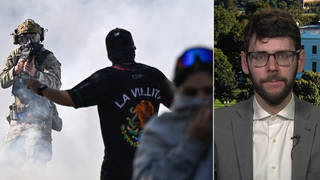
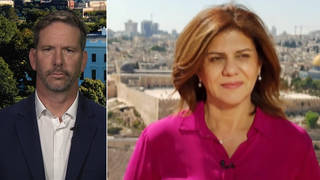
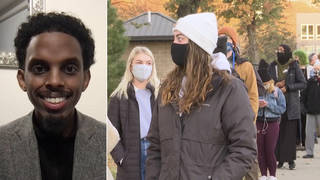
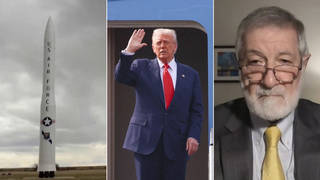





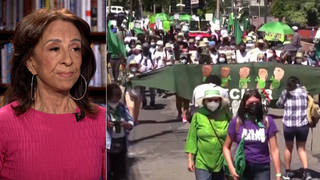
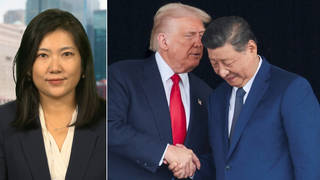
Media Options